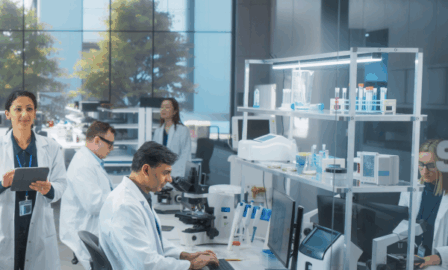The Latest with LabVantage: CTEC 2023 Takeaways
Clarkston’s LIMS experts recently attended LabVantage’s North American Customer Training and Education Conference (2023). The event brought the LabVantage community together to gain new skills, share best practices, network with fellow LabVantage customers, and discuss new solutions to help solve the latest challenges within the LIMS space. Below, Tina Yauger shares key takeaways and themes from CTEC 2023 and what to expect with LabVantage in the months to come.
LabVantage CTEC 2023
1. LabVantage for the Future: Generative AI
LabVantage has merged with Biomax Informatics in a strategic effort to “increase new scientific discovery, product ideation, and value-added services.” The use of Biomax within LabVantage will allow better decision-making using AILANI, a generative artificial intelligence (AI) solution that combines semantic modeling, linguistics, and AI algorithms. AILANI works similarly to ChatGPT, where queries are expressed in human language and can display results in appropriate context. AILANI was designed for the life sciences industry, but it could certainly be useful in other sectors. By integrating resources of internal documents, experiments, and data (public or private), AILANI can aid in inferring the knowledge and interpreting it through the data, which is done with AI algorithms that generate search results. This can also be used to search for things that a Structured Query Language (SQL) would not be able to produce, such as for a chemical structure, plate readout, or sound that would be critical to laboratory data, research, and development.
2. New Features for LabVantage 8.9
LabVantage teased the release of new features in its next release (8.9), expected in mid-2024, including data retention and removal, added barcode scanning within data entry, a new stability user interface (UI), and more.
-
- Data Retention and Removal: Something that we often think about with big data is data retention and data removal. Over years of use in a LIMS, data grows exponentially over that time. GxP and Regulatory factors play a part in how long data needs to be maintained, but some data can be removed over time, perhaps for legal reasons or to reduce management costs. Oftentimes, people do this in hopes of performance improvements, but typically database data amounts are not a key factor in performance issues. Historically, this would include a database archive, database backups, and proving accessibility of archived data, all adding up to a heavy lift. The current thinking to mitigate this challenge is a new SDC – Sapphire Data Collection – called a Data Removal Plan, which will define removal rules. The execution of the plan will remove specific SDIs (Sapphire Data Items) and provide a record of who, when, and what was removed. The Data Removal Policy will then define how the data should be removed (i.e., should attachments also be removed, remove only audit trails, etc.)
- Added Barcode Scanning: Added barcode scanning will allow for scanning on multiple columns, not just the primary key for that list page. An example would be to scan by an SDI alias or an external ID. Scannable barcodes will also be added to the data entry page so that an analyst can add a sample for data entry without having to leave the data entry page.
- Improved Stability: Stability in LabVantage is getting a makeover – an entirely new user interface. Historically, stability usability in LabVantage has had issues with copy/paste, multiple views of timepoints, and complex property grids that need knowledge an average end user wouldn’t necessarily know. They will use STELLAR Framework (LabVantage name for the new UI and UX) to drive the user interface and aid as the server-side communication layer. STELLAR has built-in speech recognition, security, and web sockets for efficient bidirectional communication. Stability with this framework has gained not only an aesthetic upgrade with dark mode ability, but also a simplified approach to protocol creation, testing definitions, and adding tasks.
3. LabVantage Analytics Training
Enhancements to TCG Digital Analytics Platform will provide expanded calibration curve ability. LabVantage Analytics (LVA) is powered by TCG MCube. The AI platform has raw data that is entered through data ingestion through a series of different abilities, such as LabVantage data, an ERP system, flat files or CSV files, IoT (Internet of things), or cloud services. This data then goes to a big data store, such as a data lake, where the data is managed and then contextualized. It goes through its platform services in real-time capability to then run AI models to predict forecasting, optimizations, or “What ifs?” It can also perform Business Intelligence models for dashboards or relational searching. LVA also has the capability to run calibration curves, analyze plates, and produce mathematical analytic values with the click of a button.
4. Reshaping Traditional Products as Complexity Grows
Traditional labs are moving toward more digitization and automation, approaching a mixed reality. The “Lab of the Future” is something we think about in life sciences as innovation and technology growing at a rapid pace. How can we get results faster, save time, and cut costs to produce a product that meets above and beyond the quality standards we strive for? Being able to turn data into knowledge is a huge step forward for lab digitization. Automation of results from instruments has been a feature of LIMS for many years, but now we are automating testing, reporting, and validation. We are using AI and ML to predict failures and successes. Now, mixed reality in the lab has been added to the wave of the future.
The Future of LabVantage
LabVantage has been a key player in the LIMS space for more than 30 years, and the innovation they can deliver will keep them at the forefront of the industry. In life sciences, we often view change as uncomfortable. It’s highly regulated with repeatable outcomes and processes. While the new technology will ultimately make processes faster, easier, safer, more cost-effective, and less wasteful, adapting to change is difficult, and it will take strong change management initiatives to ensure success. Some of this new technology will come with additional licensing costs, increased validation efforts, and learning curves. However, the upfront efforts will be worth the downstream benefits.
If you’re interested in chatting more about LabVantage and the future of the LIMS space, Clarkston can help.



